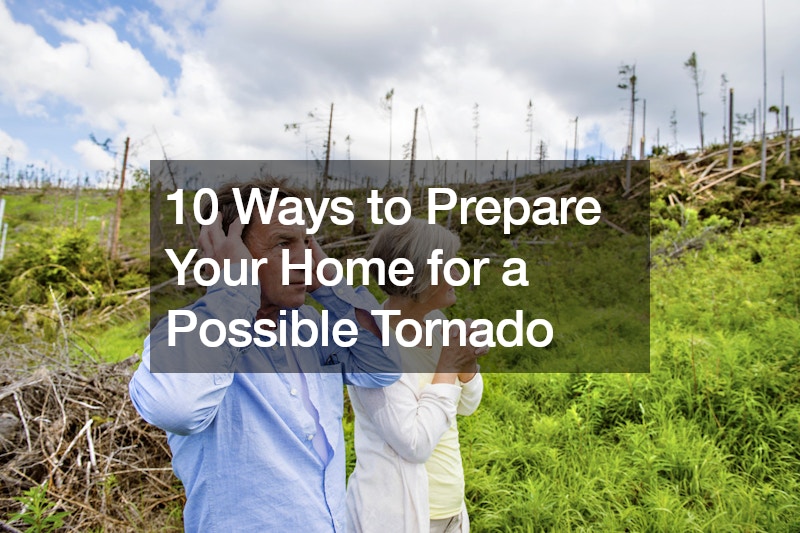10 Ways to Prepare Your Home for a Possible Tornado


Introduction
Preparing for a tornado is essential for safeguarding your home, family, and possessions from the destructive forces of nature. Tornadoes can strike suddenly and cause significant damage within minutes, making proactive preparation crucial for minimizing risks and ensuring everyone’s safety. In this comprehensive guide, we’ll explore ten essential steps you can take to prepare for a tornado, covering everything from securing your home and belongings to staying safe during and after the storm. By following these guidelines and being proactive in your preparations, you can increase your chances of weathering the storm and protecting what matters most to you.
1. Invest in Home Insurance

When preparing for a tornado, one of the most important steps you can take is to invest in comprehensive home insurance coverage. A robust insurance policy can provide financial protection against damage to your home, belongings, and property caused by tornadoes or other natural disasters. Start by obtaining insurance quotes from reputable providers to compare coverage options and premiums. Look for policies that offer coverage for windstorm damage, hail damage, and other perils commonly associated with tornadoes. Additionally, consider adding endorsements or riders to your policy for additional protection against specific risks. By securing adequate home insurance coverage, you can have peace of mind knowing that you’re financially prepared for the aftermath of a tornado.
Furthermore, it’s crucial to review your insurance policy regularly to ensure it reflects any changes or improvements made to your property. As your home evolves, such as through renovations or upgrades, the value of your property may increase. It’s essential to adjust your coverage limits accordingly to ensure that your insurance adequately protects your investment. Additionally, consider conducting a home inventory to document your belongings and their value. This inventory can be invaluable in the event of a loss, helping you accurately assess your losses and file a claim with your insurance provider more efficiently.
In addition to standard home insurance, consider purchasing flood insurance if you live in an area prone to flooding, which can often accompany tornadoes. Many standard home insurance policies do not cover flood damage, so a separate flood insurance policy may be necessary to protect your home and belongings. Remember that flood insurance typically has a waiting period before coverage takes effect, so don’t wait until a storm is imminent to purchase coverage. Investing in both comprehensive home insurance and flood insurance can provide comprehensive protection against the financial devastation of tornado-related damage.
2. Secure Your Vehicle
In addition to protecting your home, it’s essential to secure your vehicle against potential damage during a tornado. Flying debris and strong winds can cause significant damage to vehicles left outdoors during a storm, so it’s crucial to take preventive measures to minimize risks. Consider taking your car to a professional car detailer to have it inspected and prepared for severe weather conditions. This may include securing loose parts, checking tire pressure, and ensuring that the vehicle is in good working condition. Additionally, if a tornado warning is issued, move your vehicle to a safe location, such as a garage or covered carport, to protect it from potential damage. By securing your vehicle proactively, you can reduce the risk of costly repairs or replacements in the event of a tornado.
Moreover, it’s essential to have an emergency kit stored in your vehicle in case you’re caught on the road during a tornado or severe weather event. This kit should include essential items such as water, non-perishable food, a flashlight, a first-aid kit, and blankets. Additionally, consider keeping a spare tire, jack, and tire iron in your vehicle in case you need to make emergency repairs. Having these supplies readily available can help ensure your safety and well-being until help arrives.
Furthermore, staying informed about weather conditions and having a plan in place can help you make informed decisions about how to protect your vehicle during a tornado. Monitor weather forecasts regularly and heed any tornado warnings or watches issued for your area. If a tornado warning is issued, seek shelter immediately and avoid driving until the storm has passed. By staying vigilant and prepared, you can minimize the risk of damage to your vehicle and ensure your safety during severe weather events.
3. Store Fresh Water
One of the most critical resources to have on hand during and after a tornado is clean, fresh water. After all, you don’t want to be left with dirty water! Tornadoes can disrupt water supplies and cause contamination of drinking water sources, making it essential to have an adequate supply of clean water stored for emergencies. Store at least one gallon of water per person per day for drinking and sanitation purposes. Additionally, consider storing extra water for household tasks such as cooking, cleaning, and hygiene. When storing water, use food-grade containers that are designed for long-term storage and avoid containers that may leach harmful chemicals into the water. Regularly check and replace stored water as needed to ensure freshness and quality. In the event of a tornado, having a sufficient supply of clean water on hand can help you stay hydrated and healthy until normal water services are restored.
Furthermore, it’s essential to have a plan for treating and purifying water in case your stored supply runs out or becomes contaminated during a tornado aftermath. Portable water purification devices, such as water filters or purifying tablets, can help make water from questionable sources safe for drinking. Familiarize yourself with the proper use of these devices and keep them readily accessible in your emergency kit. Boiling water is another effective method for purifying water and killing harmful bacteria and viruses. If you’re unable to boil water, consider using household bleach to disinfect water. Follow guidelines for proper dilution and contact time to ensure effective disinfection. By having the necessary tools and knowledge to treat and purify water, you can ensure that you have access to safe drinking water during and after a tornado.
Moreover, it’s essential to educate yourself and your family about water conservation techniques to make the most of your stored water supply during a tornado or other emergency. Implementing simple measures such as taking shorter showers, turning off faucets when not in use, and using water-saving appliances can help stretch your water resources and minimize waste. Additionally, consider collecting rainwater or using alternative water sources for non-potable purposes such as flushing toilets or watering plants. By practicing water conservation habits and utilizing alternative water sources, you can prolong the availability of clean water and ensure that your household’s needs are met during times of crisis.
4. Install Quality Roofing

Investing in quality roofing is essential for protecting your home from the damaging effects of tornadoes. Strong winds associated with tornadoes can cause significant roof damage, leading to water infiltration and structural issues. When selecting roofing materials, opt for durable options such as asphalt shingles, metal roofing, or concrete tiles that can withstand high winds and flying debris. Additionally, ensure that your roof is properly installed by hiring reputable roofing contractors who have experience with tornado-prone areas. By installing quality roofing materials and ensuring proper roof installs, you can enhance the resilience of your home and reduce the risk of damage during a tornado.
5. Stay Off the Roads
During tornado warnings or severe weather events, it’s crucial to stay off the roads and avoid unnecessary travel. Tornadoes can strike suddenly and without warning, making travel dangerous and potentially life-threatening. If you must travel during severe weather, exercise extreme caution and stay informed about weather conditions by listening to local authorities and weather reports. Keep a fully stocked emergency kit in your vehicle, including water, non-perishable food, a first-aid kit, and emergency supplies. Additionally, consider consulting with an accident attorney to understand your rights and legal options in the event of a weather-related accident. By staying off the roads during tornado warnings, you can reduce the risk of accidents and injuries and prioritize your safety and well-being.
6. Look to Backup Energy Sources
During tornadoes or severe weather events, power outages are common and can last for extended periods. To ensure continuity of power and stay comfortable during outages, consider investing in backup energy sources such as generators or heating oil delivery systems. Generators can provide temporary power to essential appliances and systems in your home, while heating oil delivery services can ensure that you have a reliable source of fuel for heating and cooking during emergencies. Be sure to follow safety guidelines and manufacturer instructions when using backup energy sources to prevent accidents and ensure proper operation. By having backup energy sources in place, you can maintain comfort and safety for you and your family during power outages caused by tornadoes or severe weather events.
7. Prune Your Trees

Pruning your trees regularly is crucial for minimizing the risk of damage during tornadoes or severe storms. Weak or overgrown branches can become projectiles in high winds, posing a threat to your home, vehicles, and surrounding property. Hire a professional tree removal service to assess your trees and identify any potential hazards. They can safely prune or remove damaged limbs and trees that may pose a risk during severe weather. Additionally, consider planting wind-resistant tree species and maintaining a safe distance between trees and structures to reduce the likelihood of damage during tornadoes. By pruning your trees and maintaining a well-manicured landscape, you can enhance the safety of your property and mitigate the risk of storm-related damage.
8. Prevent Flooding
Flooding is a common risk associated with tornadoes and severe storms, especially in low-lying areas or regions with poor drainage. To prevent flooding in your home, invest in a sump pump system that can effectively remove excess water from basements or crawl spaces. Ensure that your sump pump is properly installed and regularly maintained to keep it in optimal working condition. Consider installing a battery backup or generator to ensure that your sump pump continues to operate during power outages. Additionally, inspect your home’s foundation and seal any cracks or gaps to prevent water infiltration. By taking proactive measures to prevent flooding, you can minimize water damage and protect your home and belongings during tornadoes or heavy rainfall.
9. Create a Shelter
Having a designated shelter area in your home can provide added protection during tornadoes or severe weather events. Choose an interior room on the lowest level of your home, such as a basement, storm cellar, or interior bathroom, as your shelter location. Reinforce the walls and ceiling of your shelter area with concrete or steel to provide additional structural integrity and protection from flying debris. Consider consulting with a concrete contractor to assess your home’s structural integrity and reinforce your shelter area as needed. Stock your shelter with essential emergency supplies, including food, water, a first-aid kit, flashlights, and a battery-powered radio. By creating a designated shelter area in your home and stocking it with emergency supplies, you can provide a safe haven for you and your family during tornadoes or severe weather events.
10. Keep Away From Windows

During tornadoes or severe storms, windows can pose a significant risk of injury from flying debris or shattered glass. To protect yourself and your family, avoid staying near windows and seek shelter in an interior room away from exterior walls. Consider installing impact-resistant window shutters or covers to provide added protection during severe weather events. Reinforce your windows with storm-resistant materials such as laminated glass or window film to reduce the risk of breakage. Additionally, ensure that your windows are securely locked and sealed to prevent water infiltration and wind damage. By keeping away from windows and fortifying them with protective measures, you can minimize the risk of injury and property damage during tornadoes or severe storms.
Conclusion
Preparing for a tornado requires proactive planning, preparation, and readiness to protect yourself, your loved ones, and your property from the devastating effects of severe weather. By investing in home insurance, securing your vehicle, storing fresh water, and implementing other essential safety measures, you can increase your resilience and reduce the impact of tornado-related risks. Remember to stay informed, stay alert, and stay safe during tornado season and always be prepared to take action to protect yourself and your family in the event of severe weather. With careful planning and preparation, you can weather the storm and emerge safely on the other side.







